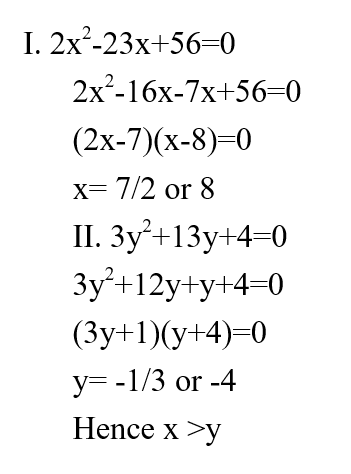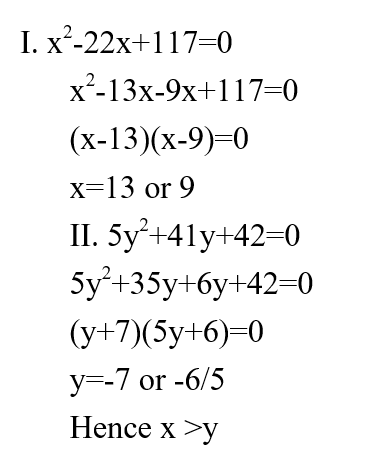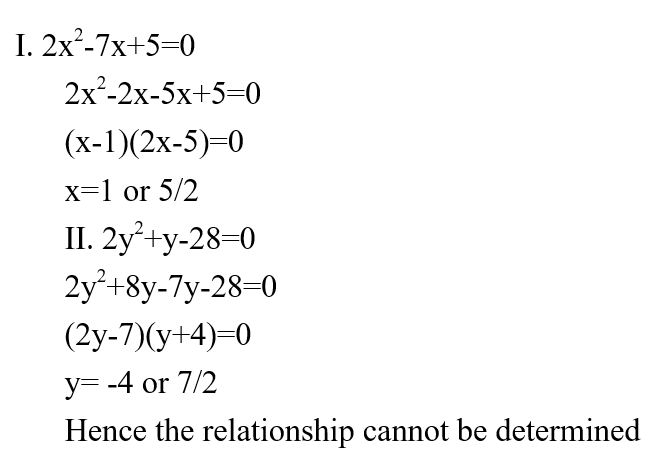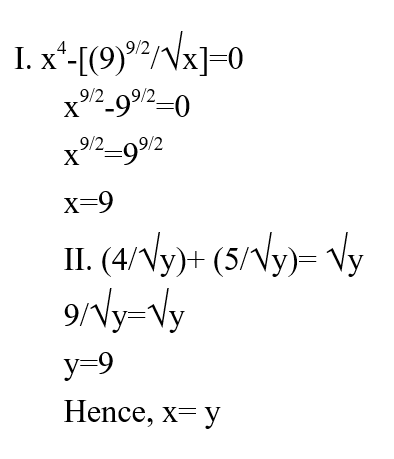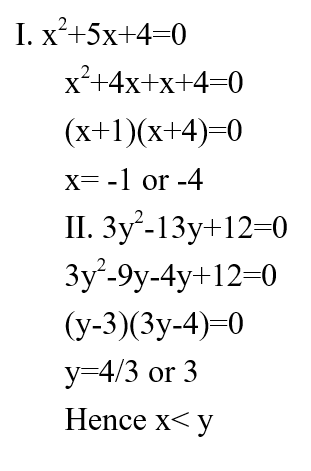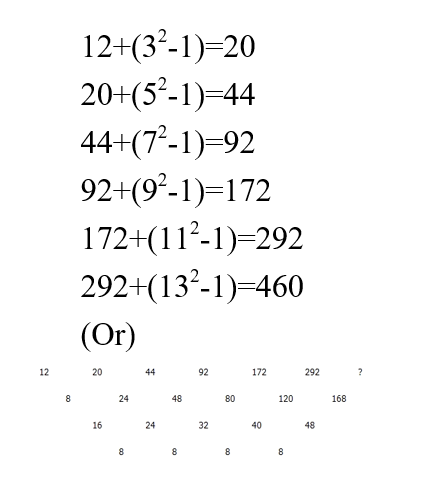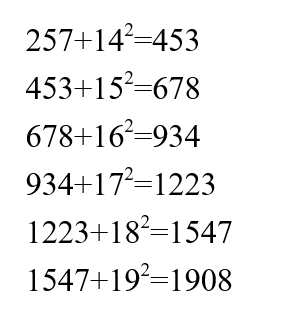Question 1:
निर्देश: निम्नलिखित में से प्रत्येक प्रश्न में, दो समीकरण (i) और (ii) दिए
गए हैं। आपको उन्हें हल करना हैं और सही विकल्प ढूंढना हैं।
Direction: In each of the following questions, two equations (i) and (ii) are given. You have to solve them and find the correct option.
(a) x >y
(b) x< y
(c) x ≤ y
(d) x ≥ y
(e) x = y Or cannot be determined x=y या निर्धारित नहीं किया जा सकता
I. x2 – 23/2 x + 28 = 0 II. 6y2 + 26y + 8=0
Question 2:
निर्देश: निम्नलिखित में से प्रत्येक प्रश्न में, दो समीकरण (i) और (ii) दिए
गए हैं। आपको उन्हें हल करना हैं और सही विकल्प ढूंढना हैं।
Direction: In each of the following questions, two equations (i) and (ii) are given. You have to solve them and find the correct option.
(a) x >y
(b) x< y
(c) x ≤ y
(d) x ≥ y
(e) x = y Or cannot be determined x=y या निर्धारित नहीं किया जा सकता
I. 2x2 – 44x + 234 = 0 II. 10y2 + 82y + 84 = 0
Question 3:
निर्देश: निम्नलिखित में से प्रत्येक प्रश्न में, दो समीकरण (i) और (ii) दिए
गए हैं। आपको उन्हें हल करना हैं और सही विकल्प ढूंढना हैं।
Direction: In each of the following questions, two equations (i) and (ii) are given. You have to solve them and find the correct option.
(a) x >y
(b) x< y
(c) x ≤ y
(d) x ≥ y
(e) x = y Or cannot be determined x=y या निर्धारित नहीं किया जा सकता
I. x2 – 7/2 x + 5/2 = 0 II. y2 + y/2 – 14 = 0
Question 4: 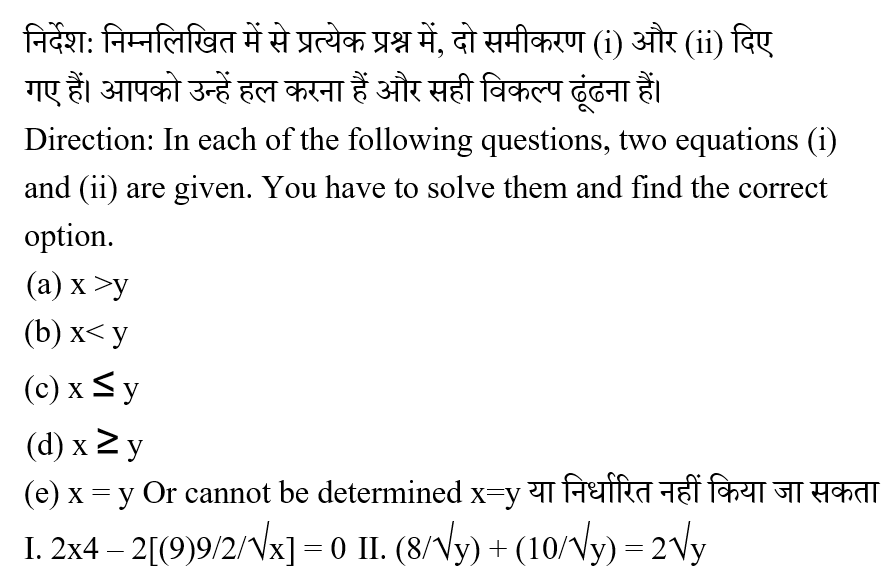
Question 5:
निर्देश: निम्नलिखित में से प्रत्येक प्रश्न में, दो समीकरण (i) और (ii) दिए
गए हैं। आपको उन्हें हल करना हैं और सही विकल्प ढूंढना हैं।
Direction: In each of the following questions, two equations (i) and (ii) are given. You have to solve them and find the correct option.
(a) x >y
(b) x< y
(c) x ≤ y
(d) x ≥ y
(e) x = y Or cannot be determined x=y या निर्धारित नहीं किया जा सकता
I. 3x2 + 15x + 12 = 0 II. 3y2 – 13y + 12 = 0
Question 6:
निर्देश: इनमें से प्रत्येक प्रश्न में, एक संख्या श्रृंखला दी गई है। प्रत्येक श्रृंखला में, केवल एक संख्या लुप्त है। लुप्त संख्या का पता लगाएं।
Direction: In each of these questions, a number series is given. In each series, only one number is missing. Find out the missing number.
16. 12, 20, 44, 92, 172, 292, ?
Question 7:
निर्देश: इनमें से प्रत्येक प्रश्न में, एक संख्या श्रृंखला दी गई है। प्रत्येक श्रृंखला में, केवल एक संख्या लुप्त है। लुप्त संख्या का पता लगाएं।
Direction: In each of these questions, a number series is given. In each series, only one number is missing. Find out the missing number.
257, 453, 678, 934, 1223, 1547, ?
Question 8:
निर्देश: इनमें से प्रत्येक प्रश्न में, एक संख्या श्रृंखला दी गई है। प्रत्येक श्रृंखला में, केवल एक संख्या लुप्त है। लुप्त संख्या का पता लगाएं।
Direction: In each of these questions, a number series is given. In each series, only one number is missing. Find out the missing number.
8, 17, 53, 215, 1079, ?
Question 9:
निर्देश: इनमें से प्रत्येक प्रश्न में, एक संख्या श्रृंखला दी गई है। प्रत्येक श्रृंखला में, केवल एक संख्या लुप्त है। लुप्त संख्या का पता लगाएं।
Direction: In each of these questions, a number series is given. In each series, only one number is missing. Find out the missing number.
3, 9, 15, 25, 35, ?
Question 10:
निर्देश: इनमें से प्रत्येक प्रश्न में, एक संख्या श्रृंखला दी गई है। प्रत्येक श्रृंखला में, केवल एक संख्या लुप्त है। लुप्त संख्या का पता लगाएं।
Direction: In each of these questions, a number series is given. In each series, only one number is missing. Find out the missing number.
12, 13, 17, 44, 60, 185, ?

